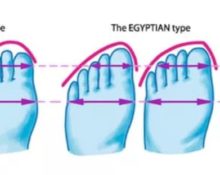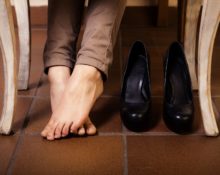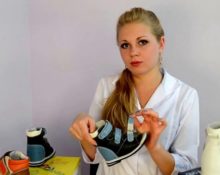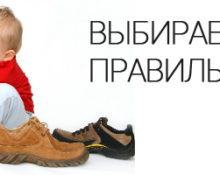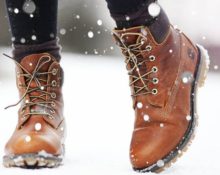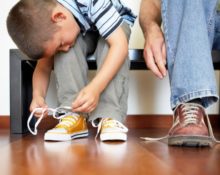Many parents believe that for the health of their baby it is enough to simply purchase orthopedic shoes from a reliable manufacturer. In fact, this approach can do much more harm than good. So which one should you choose? Read on to learn more about the correct way to select children's shoes.
Criteria for choosing the right shoes for your baby
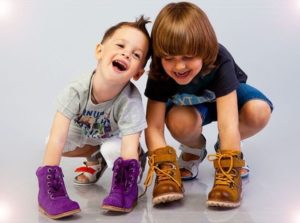 It is necessary to take into account the material (external and internal), size (do not forget that in early kindergarten the foot grows very quickly, therefore approximately every 3-4 months you have to change shoes), sole (ideal option: flexible, shock-absorbing, stable and non-slip ) and backdrop (height and rigidity matter).
It is necessary to take into account the material (external and internal), size (do not forget that in early kindergarten the foot grows very quickly, therefore approximately every 3-4 months you have to change shoes), sole (ideal option: flexible, shock-absorbing, stable and non-slip ) and backdrop (height and rigidity matter).
Additionally please note on the method of connecting parts. In one case, the seams are good (for example, on summer shoes), in another it is better to choose a model created using glue-molding technology. The latter option is ideal for walks in wet, rainy weather or during a thaw.
Material
Genuine leather has an optimal set of characteristics:
- wear-resistant, but stretches a little over time (it wears out slightly, the walls become softer and due to this, the likelihood of calluses is reduced);
- tolerates frequent washing;
- easy to process;
- withstands temperature changes better than most analogues;
- It has natural ventilation, due to which it can be worn for a long time without harm to the legs.
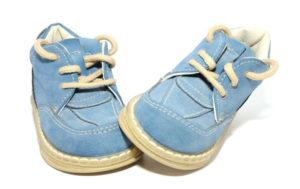 In addition to genuine leather, they deserve attention VTM – high-tech materials. They are obtained artificially, but are an order of magnitude better than ordinary leatherette: they warm well (protect the feet from hypothermia at record low temperatures), have mechanical resistance and are not afraid of contact with moisture.
In addition to genuine leather, they deserve attention VTM – high-tech materials. They are obtained artificially, but are an order of magnitude better than ordinary leatherette: they warm well (protect the feet from hypothermia at record low temperatures), have mechanical resistance and are not afraid of contact with moisture.
Textile models in some cases also seem to be a good solution. For example, the material is suitable for creating summer shoes. However for the smallest babies who have not yet turned 6–7 years old, textile shoes are contraindicated for the reason that they do not have a hard enough heel.
Sole
Flexibility in the arch and toe area is the key to a good option. Additionally, pay attention to the inserts on the sole that are original in appearance and design.. Each such element has certain functions. For example, shock-absorbing. However, such inserts must be located pointwise, locally. If they divide the sole into 2 or more parts, this is a bad shoe.
Important! There must be a roll in the front part of the sole of the shoe.
Another guideline is the material of the sole. Formulations containing plastic are not permitted.. Such a pair will slip and crack due to temperature changes.For the youngest children who are going to try on their first shoes, models with soles made of genuine leather are recommended. Such products are expensive, but only they meet the requirements.
Heel
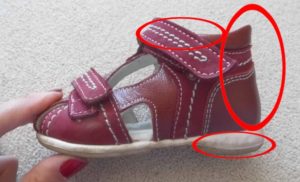 Even for a kindergartener who has been visiting the school for several years, the back of the shoe should rise no more than 1-1.5 cm. This rule also applies to shoes for girls, including holiday models. However An absolutely flat sole is not a sign of a safe shoe for a child. A small transition must be present.
Even for a kindergartener who has been visiting the school for several years, the back of the shoe should rise no more than 1-1.5 cm. This rule also applies to shoes for girls, including holiday models. However An absolutely flat sole is not a sign of a safe shoe for a child. A small transition must be present.
Clasps
A small child will not be able to handle the laces on his own, and the lock will eventually begin to jam due to frequent “walks” through puddles. Velcro and elastic bands on the boot will serve much better.
Arch support
An instep support is a small thickening or elevation located on a limited area of the inner part of the sole. Its role is the prevention of flat feet. If the pathology is already present, there is no need for an arch support.
Backdrop
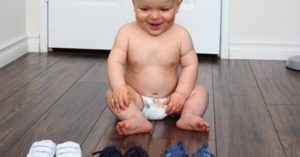 Children should wear shoes until about 3 years of age with a very hard spot (but not too much; some flexibility is still needed). This backdrop holds the leg well and prevents it from deviating in one direction or another. This contributes to the formation of correct foot and gait.
Children should wear shoes until about 3 years of age with a very hard spot (but not too much; some flexibility is still needed). This backdrop holds the leg well and prevents it from deviating in one direction or another. This contributes to the formation of correct foot and gait.
Sock
Best option: round, reinforced, slightly flared (toe should be wider than heel). And while older children can still buy open-toed sandals, they are contraindicated for children under 3–4 years old.
Shoes for the first steps - what?
It should not be heavy and massive, it should not have a pointed toe or heel (platform). These postulates are explained as follows:
- walls that are too high cause chafing, walls that are too wide add mass;
- the weight pulls down, complicates the process of getting used to the fact that there is something on your feet;
- It is easier for a one-year-old child in heavy shoes to take off his shoes, and he will take advantage of any convenient moment to free his feet from the weight;
- the heel and platform reduce stability and give the child an inaccurate idea of the distance to the ground;
- a pointed nose is bad because it does not allow the front part of the leg to develop correctly;
- Frequently wearing pointed shoes can lead to ingrown toenails.
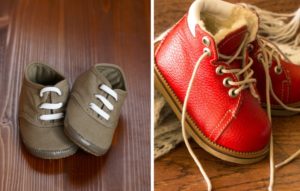 Should be carefully considered question of flexibility of walls and back. The ideal option for the first steps has a balance of hardness and softness. If you choose an overly soft one, the leg will collapse and the child will begin to clubfoot. If it is too hard, it will be painful for the baby to walk and he will develop calluses.
Should be carefully considered question of flexibility of walls and back. The ideal option for the first steps has a balance of hardness and softness. If you choose an overly soft one, the leg will collapse and the child will begin to clubfoot. If it is too hard, it will be painful for the baby to walk and he will develop calluses.
The type of fastener must be reliable, but as simple as possible. Simplicity is not needed so that the child learns to put on his own shoes - this will not happen very soon. Quality will make life easier for the parents themselves, who will be faced with the need to often, much more often than in the case of older children, put on and take off their baby’s shoes.
It is also important to understand that orthopedic shoes – therapeutic. A healthy baby doesn't need it. If an orthopedist, neurologist or surgeon has prescribed it, then you need to go not to a regular store, but to a place where they can make a pair that optimally meets the needs of a particular child.
Important! The key role in the issue of corrective shoes is played by the level or angle of curvature. You need to find out this parameter, otherwise the therapeutic effect of wearing it will be low.
Should I take it “for growth”?
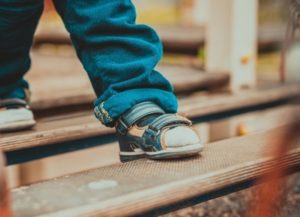 You won't be able to save on shoes this way.If you try, you will face consequences in the form of incorrect foot placement and twisted knees. And all because large shoes are less stable, unevenly load the foot, do not support it where it is needed and slow down the gait. This leads to the fact that the baby begins to tuck his leg, put it sideways and keep his knees bent.
You won't be able to save on shoes this way.If you try, you will face consequences in the form of incorrect foot placement and twisted knees. And all because large shoes are less stable, unevenly load the foot, do not support it where it is needed and slow down the gait. This leads to the fact that the baby begins to tuck his leg, put it sideways and keep his knees bent.
How to choose the right size?
You need to measure the leg, add 1.5 cm to the result obtained (in the case of winter boots - 2 cm), and then find the amount in a specialized table.
Measuring the leg
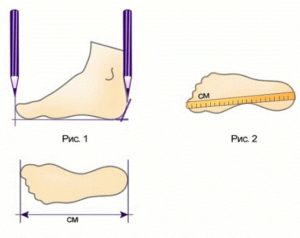 There are 2 ways. The first comes down to measuring the foot using a measuring tape, the second - to outlining it. For the last option, place the baby on a piece of paper, make sure that he does not bend his fingers and trace the outline with a pencil. As a result, you should get 2 drawings: left and right legs. The number is explained by the fact that children and adolescents relatively often wear shoes of different sizes on different feet.
There are 2 ways. The first comes down to measuring the foot using a measuring tape, the second - to outlining it. For the last option, place the baby on a piece of paper, make sure that he does not bend his fingers and trace the outline with a pencil. As a result, you should get 2 drawings: left and right legs. The number is explained by the fact that children and adolescents relatively often wear shoes of different sizes on different feet.
Important! Regardless of the measurement method you choose, take measurements only in the afternoon.
Then a ruler is applied to the drawing. It should be placed between the end of the big toe and the most prominent point of the heel. The tape measure, the first method of measuring the foot, is used in a similar way. There is only one difference: you need to ask the child to stand correctly not on a piece of paper, but on a measuring device.
Important! Do not measure in a lying or sitting position, the data obtained in this way will not correspond to reality. Reason: under the weight of the body, a small child’s foot lengthens by several mm.
The resulting value must be written down so as not to forget and correctly determine the number of additional cm.For winter shoes add 1.5-2 cm, for demi-season and summer shoes 1-1.5 cm.
Important! Do not try to check the shoe size for the foot length by placing your finger between the child's heel and heel. Kids do not understand the essence of what is happening and quite often curl their toes when they feel excessive pressure on the back of the leg. Thus, they try to fit more comfortably into a limited space.
What is completeness?
Fullness correlates with the height of the leg. Often in the youngest children this figure is very high. Therefore, they need to purchase models that are very loose inside and options with adjustable fasteners. The presence of elastic inserts is also welcome.
Indicators of incorrect completeness:
- the foot hardly squeezes into the shoe, although its size corresponds to the length of the foot;
- During the fitting, it is clear that the leg “wobbles”, although the heel and toe meet the rigidity requirements.
Russian size chart
Having found out the length of the foot, check the data obtained with the table. At the same time, remember that it is Russian. In Europe, China and the USA, metric systems are used that are different from the domestic one.
Sizing example
- We put the child on a piece of paper. We outline the left and right foot.
- We place a ruler between the big toe and the heel of the right foot, then the left. We record the results.
- Let the length of the right leg be: 12.4 cm. The length of the left leg: 12.3 cm.
- We determine the seasonality of the model. Let it be winter as an example.
- Since winter shoes are needed, and the child is small (not even 2 years old), then we add 1.5 cm to the results obtained.
12.4 +1.5 = 12.9 cm.
12.3 + 1.5 = 12.8 cm.
- We look for values in the size table. There are no such numbers, but there is an option for 13 cm.We take it as a basis (we simply round the values up).
- A foot of 13 cm corresponds to shoe size 21.
- We buy shoes or boots for winter, wear them with warm socks (for this reason 1.5 cm was added).
Shoes by season - how to determine?
Children often buy rubber boots for spring and autumn. This should not be done for the following reasons:
 the design does not provide a solid backdrop;
the design does not provide a solid backdrop;- the upper edge of the boot can rub (the boot is wide, dangles on the leg, and if the material is not soft enough, then the combined factors lead to damage to the skin);
- no shock-absorbing qualities.
The absence of the last characteristic becomes a significant disadvantage when running. Instead of rubber boots, which are not always able to ensure dry feet (water enters through the wide boot) and an appropriate level of hygiene, you should choose membrane and leather boots created using glue-molding technology. It is good because it does not allow water to pass through.
Important! Nubuck and suede are not recommended in autumn and spring for the reason that they do not tolerate contact with moisture well and this is critical in the case of small children.
When choosing membranes, look where the layer of the same name is located. According to this criterion, a distinction is made between winter (it is located inside) and demi-season footwear (it is the basis of the top). The difference between seasonal patterns is critical. Thus, separate membrane boots for the winter protect the foot even at -30 degrees; autumn boots cannot boast of anything like that.
Important! Do not buy snowboots - membrane dummies - for children under 3 years of age and for constant wear by older kindergarteners (if your child is over 3 years old and you are not going to wear snowboots so often, you can buy them).Their use can lead to foot problems.
Another good option for wearing from December to February is boots made of genuine leather with natural fur lining. This combination maintains normal hygienic conditions, prevents feet from sweating and freezing, wears out for a long time and does not react to sudden temperature changes.
In summer there is nothing better than sandals. And it’s not just that they don’t fall off your feet like flip-flops or make them heavier. The model is adapted for prolonged daily use and keeps the ankle in the correct position.
Shoes for indoors, sports and other events
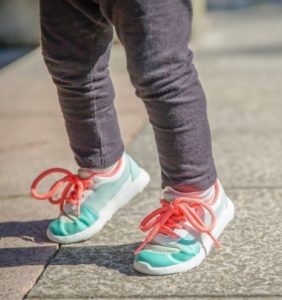 For constant wearing in a group, take leather sandals with a locking heel, Velcro fasteners and a round toe. Other shoe models will not fit. Some are unsuitable due to their closed nature (being in shoes that don’t breathe well all day is very harmful), others due to their design features. For example, flip-flops are not suitable due to the open back. It is contraindicated up to 5–6 years of age.
For constant wearing in a group, take leather sandals with a locking heel, Velcro fasteners and a round toe. Other shoe models will not fit. Some are unsuitable due to their closed nature (being in shoes that don’t breathe well all day is very harmful), others due to their design features. For example, flip-flops are not suitable due to the open back. It is contraindicated up to 5–6 years of age.
Sneakers are recommended for physical education, but It’s better to avoid wearing sneakers – at such a young age they can cause flat feet. If the child is engaged in a section, then the shoes should be specialized. By doing so, you will protect the beginning athlete from injury and speed up his progress.
You can afford beautiful shoes for the holidays, but beauty does not lie in big heels. For events, buy a pair where the sole in the back is 1.5 cm higher than the front, but no more.
Shoes “inherited” and its disadvantages
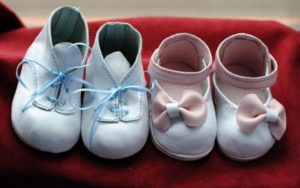 Worn shoes, boots and sneakers are akin to fingerprints. They demonstrate the structural features of their owner's feet. Having adapted to the previous owner, they will not fit another child's foot. And this baby will begin to experience discomfort, be capricious and refuse to walk. The process of getting used to shoes will become more difficult.
Worn shoes, boots and sneakers are akin to fingerprints. They demonstrate the structural features of their owner's feet. Having adapted to the previous owner, they will not fit another child's foot. And this baby will begin to experience discomfort, be capricious and refuse to walk. The process of getting used to shoes will become more difficult.
Someone else's shoes can be hazardous to health. Especially if the previous owner had foot problems or his parents did not take good care of the boots, did not wash them thoroughly enough.
Not all pediatricians agree with the above points. Thus, Dr. Komarovsky insists that there is nothing wrong with a child “inheriting” sandals or boots from an older brother or sister. The only thing you need is ensure proper level of hygiene: Thoroughly wash and treat the donated shoes. During the procedure, you should pay close attention to the joints and seams. It is in them that microorganisms usually accumulate and actively multiply.
Manufacturers: which ones to choose?
Brands to look out for:
- Kotofey;
- Playful;
- Nordman;
- Kapika;
- ECCO;
- Viking;
- Lassie.



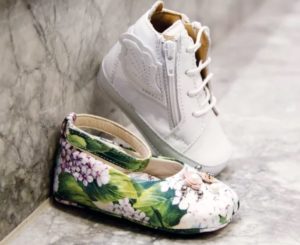
 0
0